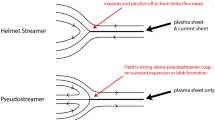Abstract
It is proposed that the Kirkwood Gaps are primordial, representing regions where asteroids failed to form by accretion. A brief scenario is presented to indicate the main features of a model for the early history of the asteroids. An analytical treatment is given for the effects of a solar nebula upon the eccentricity-pumping of asteroids, due to secular perturbations and to commensurability-type resonances associated with Jupiter. It is shown that nebular effects promote growth of main-belt asteroids; but in commensurability regions, growth is inhibited. A discussion is given of two related problems: the origin of asteroidal eccentricities and inclinations, and the likelihood that Jupiter suffered major changes in its semimajor axis during its formation. It is suggested that in view of these problems, the present theory should not be taken as necessarily correct, but should be regarded as illustrative of viewpoints which in time may yield a correct theory.
Similar content being viewed by others
References
Anders, E.: 1965,Icarus 4, 398.
Brouwer, D.: 1951,Astron. J. 56, 9.
Brouwer, D.: 1963,Astron. J. 68, 152.
Brouwer, D. and Clemence, G.M.: 1961,Methods of Celestial Mechanics, Academic Press, New York; pp. 508–515.
Goldreich, P. and Nicholson, P.: 1977,Nature 269, 283.
Goldreich, P. and Tremaine, S.: 1978,Icarus 34, 240.
Goldreich, P. and Ward, W.R.: 1973,Astrophys. J. 183, 1051.
Greenberg, R., Davis, D.R., Hartmann, W.K., Chapman, C.R.: 1977,Icarus 30, 769.
Heppenheimer, T.A.: 1980,Icarus 41, 76.
Kaula, W.M. and Bigeleisen, P.: 1975,Icarus 25, 18.
Weidenschilling, S.J.: 1977,Astrophys. and Space Sci. 51, 153.
Extra References
Chapman, C.R. and Davis, D.R.:Science 190, 553.
Dohnanyi, J.S.: 1969,J. Geophys. Res. 74, 2531.
Franklin, F.A., Marsden, B.G., Williams, J.G., Bardwell, C.M.: Astron. J.80, 729.
Scholl, H.: 1979, inDynamics of the Solar System (R.L. Duncombe, ed.), IAU Symposium 81, p. 217.
Author information
Authors and Affiliations
Rights and permissions
About this article
Cite this article
Heppenheimer, T.A. On the origin of the Kirkwood Gaps. Celestial Mechanics 22, 297–304 (1980). https://doi.org/10.1007/BF01229515
Received:
Issue Date:
DOI: https://doi.org/10.1007/BF01229515




